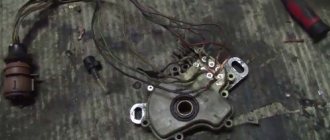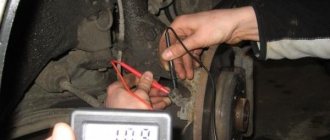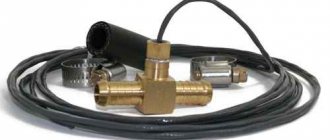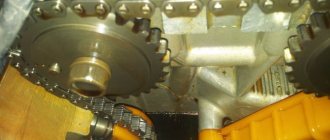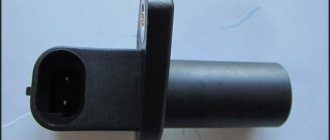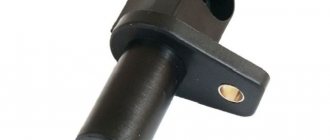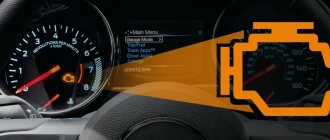Modern cars are equipped with a large number of sensors, among which the crankshaft position sensor plays an important role. It provides synchronous fuel supply and ignites the mixture in the chamber. The article talks about the main functions, symptoms of a faulty crankshaft sensor, as well as the main ways to eliminate them.
The transition from carburetor to fuel injection was a real revolution in the automotive industry. The operation of modern car engines is highly dependent on the electronic components of the car. Information about the functioning of the entire system is accumulated in the control unit. After its analysis, the operation of individual nodes is adjusted. To collect such information, the car is “stuffed” with hundreds of sensors, one of which is the crankshaft position sensor (CPS, or synchronization sensor). His area of responsibility is the reliable operation of the engine. Below we will talk about checking the crankshaft sensor using a multimeter and an oscilloscope.
Symptoms of a bad timing sensor
A breakdown of the crankshaft sensor is manifested by:
— a noticeable decrease in engine power;
— “floating” engine speeds;
— detonation triggered in the engine during active movement;
- absence of signs of life in the sensor, when it is impossible to start the car.
The presence of such problems indicates the need to check the crankshaft position sensor.
Incorrect operation of the DPKV is manifested by:
- a noticeable deterioration in its dynamic characteristics when driving the car (the reasons for this problem may be different, but if the malfunction concerns the synchronization sensor, then “check engine” will appear on the instrument panel).
— spontaneous decrease or increase in speed;
— lack of stability in speed;
— the phenomenon of detonation in the engine accompanying dynamic load;
- inability to start the engine.
This is only an incomplete list of characteristic symptoms of crankshaft speed sensor malfunctions.
It is important to understand how you can check the functionality of a given unit in order to be absolutely sure that it is working properly. This check should always be carried out first, and here's why. Despite the rather inconvenient location of the crankshaft sensor in most cars, the process of checking it is relatively simple. But you will know for sure whether the sensor needs to be changed or not.
Crankshaft sensor device
The crankshaft is a metal part of complex shape that has journals for attaching connecting rods.
It is an integral part of the crank mechanism (CSM). The main function of the part is to convert the forces received from the connecting rods into torque. The crankshaft position sensor (CPS) is a sensor that reads electromagnetic pulses from the crankshaft pulley and sends them to the on-board computer. The synchronization of the operation of the ignition system and fuel injectors depends on the dpkv. At the very end of the article you will find a selection of video checks!
Today in the automotive industry there are 3 types of DPKV
: optical, induction and based on the Hall effect. In this article we will tell you how to check the crankshaft sensor, using the most popular induction type as an example.
- Induction
- consists of a magnetized core on top of which copper wire is wound. The end of the coil is located as close as possible to the crankshaft to measure its rotation speed and voltage changes; - Optical
- it is based on an LED emitting light and a receiver that records the moment the light disappears and appears. When the light beam is interrupted while hitting the control tooth, the receiver records this and transmits data to the ECU; - Hall sensor
- there is a magnet on the crankshaft, when passing past the sensor, a direct current arises in the latter, the data is recorded and sent to the ECU.
Regardless of the type, any DPKV sensor is designed for
transmission of 2 parameters to the ECU.
- the moment the pistons pass through top dead center and bottom dead center;
- crankshaft position measurement.
The received data is sent to the ECU, after which an adjustment occurs
the following indicators.
- Camshaft rotation angle;
- ignition timing;
- fuel mixture supply volume;
- Operation of the adsorber valve.
Depending on the technical complexity of the engine, the tasks for the ECU can vary dramatically, but none of the currently existing control units is capable of working without a crankshaft sensor!
If the crankshaft sensor is faulty, there may be malfunctions in the operation of the internal combustion engine in the form of
: delayed spark formation, advanced ignition angle, lean air-fuel mixture, all this leads to unstable engine operation or even refusal to start.
How to check the timing sensor?
There are several ways to check the serviceability of the DPKV, each of which involves the use of certain devices. Let's look at the three most commonly implemented methods for checking the performance of the crankshaft speed sensor.
First of all, before checking the sensor, it must be dismantled. In this case, it is necessary to put marks showing how it was located on the engine. The removed sensor should be inspected to identify damage and assess the condition of the contact block and contact core. Detected contaminants must be removed with alcohol or gasoline so that the crankshaft sensor contacts are clean.
When dismantling, the distance between the sensor core and the synchronization disk should be established. It should be 0.6-1.5 mm. Then you can start troubleshooting the electrical circuit of the device.
How it all works
A modern car is equipped with a large number of various sensors, the main task of which is to monitor the operation of mechanisms or systems.
Data from these sensors is transmitted to an electronic control unit, which, based on the information received, already regulates the operation of some systems.
One of the most important controls is the crankshaft position sensor (CPS, TDC sensor).
This sensor monitors the rotation speed of the engine crankshaft.
Based on the readings, the control unit regulates the operation of the fuel system and ignition system.
Simply put, based on the readings from the TDCS system, the ECU regulates how much fuel to send to the cylinders, when to deliver it, and at what point to fire the spark.
Therefore, this may be the only sensor whose failure may prevent the drive unit from starting, as failure to do so will result in fuel system failure.
Even if it starts, it will be irregular, intermittent, and so on. Therefore, this crankshaft sensor is very important and it is necessary to monitor its operation.
How to test a sensor using an ohmmeter
This method is the simplest, but it does not guarantee detection of a breakdown. The resistance of the crankshaft sensor winding can be measured with a multimeter by switching it to ohmmeter mode. For a working sensor, its value is 550-750 Ohms.
When checking with a multimeter, the resistance of the inductor is determined, since if there is damage in it, the characteristics of the sensor will primarily affect the resistance. First you need to set the desired range of values. The upper limit of resistance is usually 2 kΩ. After this, a test is performed with probes on the terminals. The resistance value should be 500-700 Ohms, but to be completely sure, it is better to carefully study the instructions for the machine and clarify this value. If the obtained numbers correspond to those indicated in the documents, then at this stage the coil can be considered serviceable, that is, you can proceed to the following verification methods. If the obtained indicators do not correspond to the interval declared by the manufacturer, the crankshaft speed sensor will have to be replaced.
CAMSHAFT POSITION (CMP) SENSORS
Because the crankshaft on a four-stroke engine rotates at twice the camshaft speed, each cylinder fires alternately. In most cases, the DPCV detects when the number one cylinder reaches TDC on the compression stroke. However, some engines do not include DPKV in their operational strategy. Instead, the ECU changes the base timing by 180° during startup and, when an increase in rotational speed is detected, the ECU identifies this position as the TDC compression stroke. See photo 2.
Photo 2
The main function of the CMP in most cases is to determine when fuel should be injected into the cylinder. In most cases, the injector sprays fuel into the intake port at approximately 26° ATDC as the intake valve approaches maximum lift.
Checking the sensor by determining the inductance value
The second way to check the performance of the DPKV is to check the inductance value. It is based on the ability of modern multimeters to measure inductance. This method is more complex and requires the use of:
— a multimeter with the function of measuring inductance or a megohmmeter;
— network transformer;
— inductance meter;
- voltmeter (ideally digital).
For the most accurate results, it is advisable to ensure the room temperature is within 20-22 degrees. To measure the winding resistance, as in the first case, an ohmmeter is used.
Then you need to measure the inductance of the winding using a special meter. For a working sensor, this figure is 200-400 mH. If the inductance reading differs greatly from this value, we can conclude that the sensor is faulty.
Then, using a megohmmeter, measure the insulation resistance of the coil wires. At a voltage of 500 V, this figure should be no less than 0.5 MOhm and no higher than 20 MOhm. If it turns out different, it means the coil has broken insulation. To obtain the most accurate data, it is better to take measurements several times.
If during repairs the synchronization disk accidentally becomes magnetized, you need to demagnetize it using a network transformer. Based on the results of the measurements, we can draw conclusions about the serviceability of the crankshaft sensor or the need to replace it. When installing the device in place, you need to focus on the marks placed during dismantling and remember the distance between the core and the synchronization disk (from 0.5 to 1.5 mm).
Verification methods
Before going to a car repair shop for a new sensor, it is recommended to check the one installed in the car.
This will make it much faster to determine the cause of a car malfunction; in fact, it may not be the sensor that is to blame, especially since some testing methods are not that complicated.
The most common:
- checking the resistance of the sensor coil;
- comprehensive control (coil resistance and insulation, winding inductance);
- oscilloscope test.
The first two checks are quite simple, you can perform them yourself with the necessary tools.
The third method is the most accurate, but it can only be tested at specialized stations.
DISTRIBUTOR
Some import distributors may include a crankshaft, camshaft and DPCV position sensor to allow the sequential fuel injection system to sense the compression stroke. Since the inline camshaft position sensor can be used to determine fuel injection timing, it is important to install the number one spark plug wire in its specified position and install the distributor and rotor in their specified positions. See Photo 3 .
Photo 3

